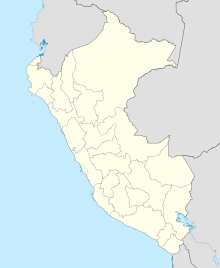Jiskairumoko
Coordinates: 16 ° 12 ′ 40 ″ S , 69 ° 45 ′ 50 ″ W.
Jiskairumoko , also Jisk'a Iru Muqu , is an archaeological site in Peru not far from Lake Titicaca in the Puno region .
Surname
The name is a combination of the Aymara words jiska 'small' , iru (a certain clump grass ) and moko 'small hill' . Jiskairumoko therefore means 'a small hill with clump grass'.
excavation
The site was described in 1994 by Mark Aldenderfer. The first excavations took place in 1995. Jiskairumoko is the first archaeological excavation in the basin of Lake Titicaca. Further excavations took place from 1999 to 2004. The excavation area has an area of about 4000 m².
Results and Interpretations
The finds date from a period between 3000 and 1400 BC. Chr.
The grave goods deserve special mention, especially the oldest gold jewelry in America, which dates from around 2155 to 1936 BC. BC could be dated.
The oldest known traces of potato cultivation have been discovered on stone tools excavated in Jiskairumoko .
Individual evidence
- ↑ Aldenderfer, MS, Craig, N., Speakman, RJ & Popelka-Filcoff, RS: 4000-year Old Gold Artifacts from the Lake Titicaca Basin, Peru. In: Proceedings of the National Academy of Sciences of the United States of America. 2008, pp. 5002–5005 , accessed April 26, 2012 (Volume 105).
- ↑ hda / ddp / dpa: America's oldest gold jewelry discovered. In: Spiegel online - Wissenschaft. April 1, 2008, accessed April 26, 2012 .
- ↑ Claudia Ursula Rumolda and Mark S. Aldenderfera: Late Archaic – Early Formative period microbotanical evidence for potato at Jiskairumoko in the Titicaca Basin of southern Peru. Retrieved November 21, 2016 .



